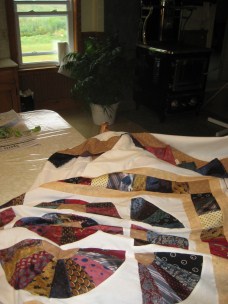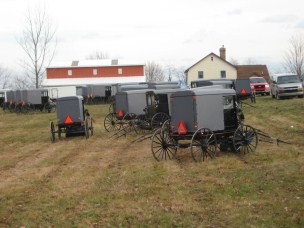
While life for the Amish quilter is often referred to as a plain and simple one, that is not to say that it is an easy and uneducated one. While it is common for an Amish quilter and all Amish children to go to school up until the eighth grade, they receive a comparable and in some ways a better education than students in the typical public school system. In fact, the Amish quilteris required to learn three separate languages in order to function within the Amish community itself and to be able to communicate with the outside world that surrounds her own. This includes learning to speak Pennsylvania Dutch, English, and High German.
Pennsylvania Dutch is a German based language that was brought to the United States by the original Amish settlers who fled Europe and made their homes in Pennsylvania and other areas of the country. Pennsylvania Dutch is really a misnomer and has nothing to do with the Dutch language. When the Amish originally settled in Pennsylvania, many people mistakenly translated Deutsch as meaning Dutch, but Deutsch actually means German in the German language. Many people now refer to the language more correctly as being Pennsylvania German, but most people still use the term Pennsylvania Dutch.
When the Amish quilter is born, her language acquisition consists primarily of Pennsylvania Dutch. According to the Amish book of laws, the Ordnung, the Amish are required to speak Pennsylvania Dutch within the home and the Amish community itself. However, because Amish children first learn the Pennsylvania Dutch language, many parents choose to speak in English when discussing matters around the children that they do not want them to overhear. Pennsylvania Dutch has been passed down over the years and is highly revered due to its connection to their ancestors who suffered persecution in Europe, but it is mainly a spoken language which has evolved over the years. Because of this, Pennsylvania Dutch has a very unique pattern, accent, and dialect to it that differs from traditional German speakers. In addition, because it is a spoken language, all written communication within the Amish community is done in English.
At the age of about five years old, the Amish quilter begins her formal schooling and is sent off to the one-room schoolhouse that is located in the Amish community. Amish schoolhouses are owned and operated by the Amish and the teacher is usually an unmarried Amish woman from the community. The young Amish quilter, or little scholar as her family calls her, will spend the next eight years studying the same subjects as other schoolchildren her age, such as mathematics, reading, and writing skills. However, subjects such as science, sports, and sex education will instead be replaced with farming, building, and home economics. One major difference for the Amish quilter, however, is that she must begin learning how to read, write, and speak English. While most kids go to school already knowing the language that will be taught, the Amish quilter must learn the language first before she can begin studying other subjects. So, while the Amish quilter is born and raised in the United States, she is essentially a second language learner when it comes to the English language.
While the Amish quilter and her family generally prefer to separate themselves from the English speaking world that surrounds them, they also understand the benefits of being able to interact and communicate with their English speaking neighbors. Because of this, the Amish quilter will learn how to speak both Pennsylvania Dutch and English fluently. Since English is also the only written language that the Amish quilter will learn, it is essential that she understands English grammar flawlessly. However, the Amish quilter is at a bit of a disadvantage when it comes to pronouncing English words correctly in some instances. Since young Amish children typically have little contact with native English speakers during their early years, they are dependent upon their Amish teacher and books to help them with pronunciation problems. The Amish quilter will not have the ability to hear the language spoken correctly by friends, on the radio, or on television, so this can sometimes be a problem early on in her English studies.
 The Amish quilter will also learn how to speak High German in school. High German is a more traditional German language that comes from the mountainous regions of Germany, where the original Pennsylvania settlers came from. High German is only spoken during church services and most people in the Amish community only know enough of the language to quote biblical passages, sing religious hymns, or say their prayers. The Amish quilter will only learn enough High German to be able to understand the language used during the church services and to read the Amish bible, which is written in High German. Church leaders will have a better understanding of High German, so as to be able to preach and lead church services in the language, but it is not used in everyday conversation within the Amish community.
The Amish quilter will also learn how to speak High German in school. High German is a more traditional German language that comes from the mountainous regions of Germany, where the original Pennsylvania settlers came from. High German is only spoken during church services and most people in the Amish community only know enough of the language to quote biblical passages, sing religious hymns, or say their prayers. The Amish quilter will only learn enough High German to be able to understand the language used during the church services and to read the Amish bible, which is written in High German. Church leaders will have a better understanding of High German, so as to be able to preach and lead church services in the language, but it is not used in everyday conversation within the Amish community.
At the end of her eighth year of formal schooling, the Amish quilter will thoroughly understand Pennsylvania Dutch, English, and High German. This will allow the Amish quilter to fully be able to socialize and participate in everything that goes on within the Amish community while also being able to fully communicate with outsiders. This might mean socializing with her Amish friends and gossiping in Pennsylvania Dutch, being able to communicate with tourists who want to purchase her Amish quilts in English, or worshipping at Sunday services with her family in High German. All three languages are essential to the daily life of the typical Amish quilter.
